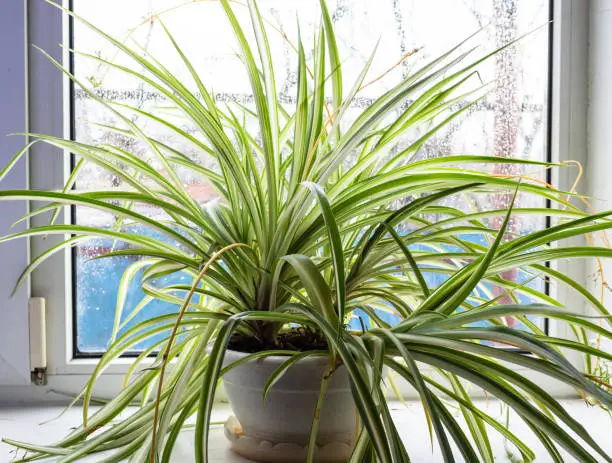Spider plants are a popular choice for indoor greenery, known for their resilience and easy maintenance. However, many plant enthusiasts yearn for lusher, fuller spider plants. In this guide, we’ll dive into the art of cultivating bushier spider plants, offering insights and practical advice to transform your spider plant into a thriving, verdant centerpiece.
1. Pruning: Encouraging Branching and Fullness
Pruning is an essential practice to maintain the health and shape of your spider plant. When you notice long, leggy stems, it’s a sign that your plant may benefit from pruning. Use clean, sharp scissors or pruning shears for this task.
To encourage branching and fullness, identify the areas where the plant seems sparse or has long stems without many leaves. Trim these stems just above a healthy, well-developed node. A node is the point where a leaf attaches to the stem. By cutting back to this point, you stimulate new growth and encourage the plant to fill out.
When pruning, avoid cutting too much at once. It’s generally better to trim a little and monitor how the plant responds before making further cuts. Regular pruning can promote a bushier and more compact appearance over time.
2. Propagation: Creating New Growth and Density
Spider plants are known for their ability to produce offshoots, or “spiderettes,” at the end of long arching stems. These baby plants can be used to create a fuller appearance in your spider plant.
When you notice spiderettes with well-established root systems, carefully remove them from the parent plant. You can then plant these spiderettes in separate pots or back into the main pot with the mother plant. This not only adds more plants to your collection but also contributes to the overall density and bushiness of the arrangement.
Propagation is an excellent method for rejuvenating an aging or leggy spider plant. It allows you to refresh the plant by replacing older sections with new, more vigorous growth.
3. Providing Adequate Light: Maximizing Growth Potential
Proper lighting is crucial for the overall health and development of spider plants. While they are adaptable and can tolerate lower light conditions, they thrive in bright, indirect light. Placing your spider plant in a location with ample sunlight will contribute to its bushiness.
Position your plant near a window where it receives bright, filtered sunlight. Avoid exposing it to direct sunlight for extended periods, as this can lead to leaf burn. By providing optimal light conditions, you create an environment that encourages robust growth and the development of a bushy appearance.
4. Optimal Watering: Maintaining Moisture Balance
Spider plants prefer consistently moist but not waterlogged soil. Proper watering is essential for preventing both under-watering and over-watering issues. When the top inch of soil feels dry, it’s an indication that your spider plant needs watering.
Use a well-draining potting mix to ensure that excess water can escape, preventing root rot. Overly soggy soil can lead to root issues, negatively impacting the plant’s overall health and bushiness.
Additionally, be mindful of the water quality. Spider plants are sensitive to fluoride, so using distilled or non-fluoridated water is recommended. Watering with suitable water quality contributes to the plant’s well-being and encourages a fuller growth habit.
5. Well-Draining Soil: Preventing Root Issues
Choosing the right soil is crucial for maintaining the health and vitality of your spider plant. A well-draining potting mix is essential to prevent waterlogged conditions that can lead to root rot.
Select a high-quality, well-aerated potting mix designed for houseplants. This type of soil promotes good drainage and allows the roots to access the oxygen they need. Well-draining soil is a key factor in creating an environment that supports the development of a bushy and thriving spider plant.
6. Fertilize Occasionally: Providing Nutrient Support
Proper nutrition is essential for the growth and development of any plant, and spider plants are no exception. During the growing season, which typically spans spring and summer, it’s beneficial to provide your spider plant with a balanced liquid fertilizer.
Dilute the fertilizer to half the recommended strength to avoid over-fertilizing, which can lead to salt buildup in the soil. Apply the diluted fertilizer approximately once a month to provide the necessary nutrients for healthy and robust growth.
Fertilizing your spider plant supports the production of lush, green foliage and contributes to the overall fullness of the plant. However, it’s essential to follow a balanced and moderate fertilization schedule to avoid any adverse effects on the plant’s health.
7. Controlled Environment: Maintaining Consistency
Creating a stable environment for your spider plant is crucial for its well-being and the development of a bushy appearance. Spider plants generally thrive in average room conditions, including moderate temperatures and humidity levels.
Avoid exposing your spider plant to extreme temperature fluctuations or drafts. Sudden changes in temperature can stress the plant and affect its growth. By maintaining a consistent and suitable environment, you provide your spider plant with the stability it needs to develop a full and bushy habit.
8. Rotate the Plant: Ensuring Even Growth
Rotating your spider plant periodically is a simple yet effective way to ensure even growth. Plants tend to grow toward a light source, and rotating the pot helps prevent one-sided growth.
By regularly turning the plant, you encourage balanced development on all sides. This contributes to a more symmetrical and bushy appearance. Rotate the pot every few weeks to promote uniform exposure to light and prevent the plant from leaning or reaching toward a specific direction.
Conclusion
In conclusion, creating a bushier spider plant involves a combination of pruning, propagation, providing optimal light and water conditions, selecting the right soil, occasional fertilization, maintaining a controlled environment, and rotating the plant for even growth.
By implementing these practices, you’ll not only enhance the appearance of your spider plant but also contribute to its overall health and vitality. Remember to observe your plant’s response to these care techniques and adjust your approach as needed. With proper attention and care, you can enjoy a lush and thriving spider plant in your home.





